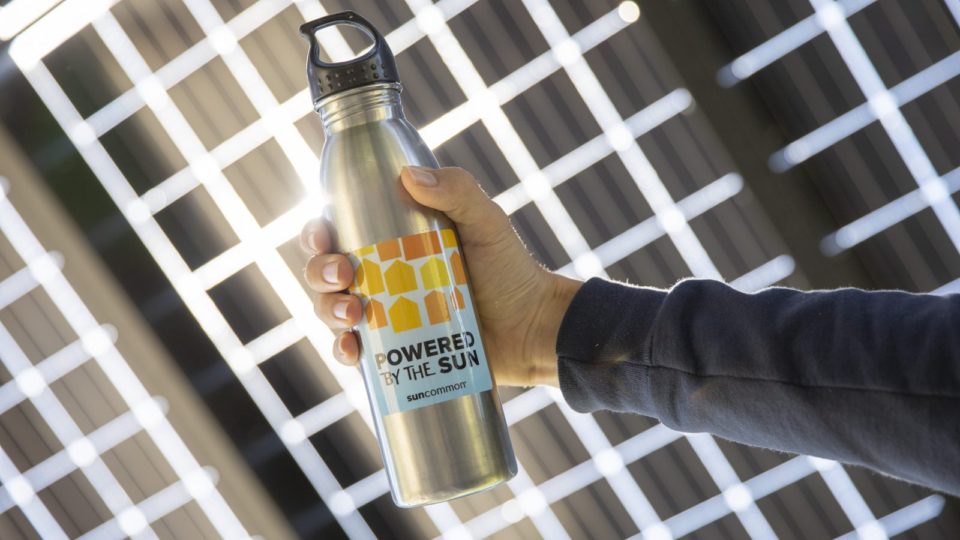Plastics are Everywhere!
Plastic Free July is a global movement, dedicated to solving the world’s dire plastic pollution problem.
By collectively reducing single-use plastics around the world and using plastic-free alternatives, we can make a difference and clean up our planet. SunCommon has encouraged our staff to participate in the Plastic Free July Challenge and track their plastics usage for the month.This challenge has really made me pause and think about all the times I interact with plastic in a day—and not just single-use plastics, but the “long-term” plastics that are just as bad for the environment. (They’ll eventually end up in landfills, too. Right?) It got me wondering, is it even possible to go plastic free? I started the challenge by taking the Pesky Plastics Quiz and then followed up by doing an inventory of all the plastic in my house. I encourage you to do the same—the length of your list may surprise you. Plastic is EVERYWHERE! And I’m realizing that because we interact with plastics so frequently and without ceremony, we’re basically oblivious to its ubiquity.
Here’s a few items in my home that are sometimes overlooked as plastic:
Single-Use Plastics:
- Cereal bags
- Caps on liquid cartons (milk, juice, etc.)
- Mascara, and generally all make-up
- Oreos. They come in a plastic tray and a plastic sleeve.
- Toothpaste tube
- Popsicle wrappers
“Long-Term” Plastics:
- Cell phone, charger, headphones
- Kitchen appliances: coffee maker, toaster oven, refrigerator
- The handles on most pots and pans
- TV
- Light switches and outlets
- Sunglasses
- Car Dashboard
So, while going a day without interacting with any plastic is nearly impossible in today’s society, going a day without single-use plastic is totally possible! There are plastic alternatives popping up on the market. And simply being more aware of all the plastic that surrounds can help us make better decisions. For instance, next time you are at the grocery store, take note of how an item is packaged. Opt for the jelly in the glass jar instead of the plastic, and choose milk that comes in a carton instead of a plastic jug. Little decisions like this do matter, and they can make a difference.
Repurpose or Eliminate Single-Use Plastics
If you’re feeling a little guilty about the plastic you do use, that’s normal. The good news is, you can repurpose or eliminate a lot of the single-use plastics in your life! Pinterest has no shortage of ideas for repurposing plastic:
- Turn a detergent bottle into a watering can or sand toy.
- Create a bottle cap curtain.
- Make a plastic bag basket.
You can eliminate some of the plastics in your life, too! There are lots of plastic alternatives coming to the market. Here are some of my favorites:
- Go plastic free on laundry day with Zero Waste, Plastic Free Laundry Detergent Strips.
- Do away with toothpaste tubes. Try Bite, Toothpaste Bits.
- Swap bottled shampoo for a shampoo bar. Make your own or try Lush Shampoo Bars.
- Replace plastic wrap with reusable Bee’s Wrap.
- Store leftovers in 100% Stainless Steel containers by ECOlunchbox.
What about Recycling?
Recycling, if done properly, can be a great solution to plastic waste. However, recycling is actually rather complicated and many of us have been “wishcycling” for years. Wishcycling happens when we toss plastic items into the recycling bin, without knowing if those items are actually recyclable. The intention is in the right place, but the result is quite the opposite. When non-recyclable items get mixed in with recyclable loads, they are considered contaminated and will be sent to landfills. Ever notice the little numbers on the bottom of plastic containers? They represent the type of plastic material the container is made with, but do not necessarily indicate if the item is recyclable. Many plastics can theoretically be recycled, but the cost of recycling it is more expensive than the cost of making new. Plus, the recyclability of each material is dependent on the municipality doing the recycling—so be sure to check out what is accepted in your area.
